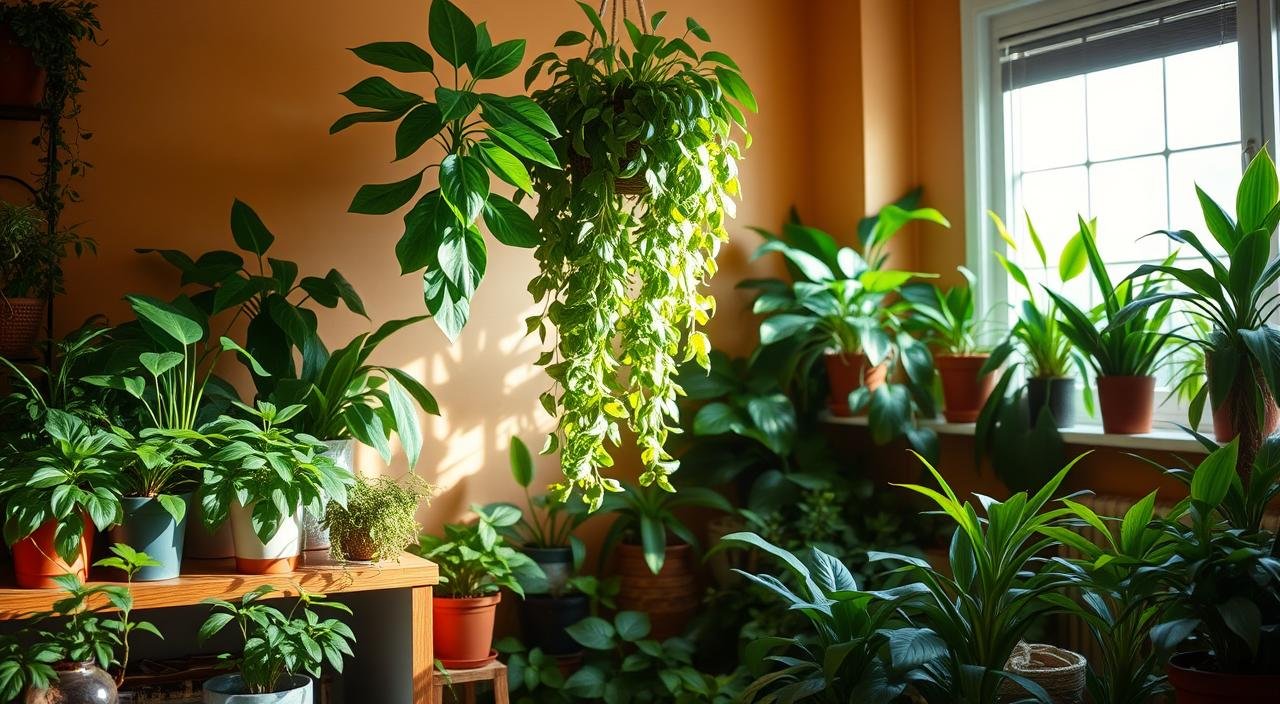Did you know that 70% of indoor plants fail because of incorrect placement, not lack of care1? Proper positioning is the unsung hero of thriving houseplants. When placed strategically, indoor plants can boost oxygen levels by up to 15% while reducing stress hormones in humans1. For example, edibles like basil and rosemary flourish near south-facing windows where light is strongest1, while ferns prefer humid corners away from dry winter drafts1. This guide reveals how smart placement maximizes indoor plant benefits—from air purification to enhancing home aesthetics.
Key Takeaways
- Optimal temperatures (60-75°F) ensure 90% of houseplants thrive better1.
- Grouping plants in threes creates natural balance2.
- Southern windows double growth rates for herbs like mint and oregano1.
- Corners with trailing plants visually expand small spaces1.
- Mobile stations let you move plants to follow seasonal light changes1.
The Importance of Indoor Plant Placement
Strategic placement maximizes indoor plant benefits while enhancing spaces. Proper positioning ensures plants thrive, from sunlit corners to shaded nooks. Research shows 85% of daily life occurs indoors, making plants essential for well-being3.
Benefits of Proper Placement
Plants placed where they receive ideal light and humidity live longer and thrive. For instance, grouping moisture-loving plants boosts humidity naturally, aiding their health4. NASA studies confirm certain plants like Boston ferns and spider plants reduce harmful VOCs, though large quantities are needed for maximum impact4. These air purifying plants placed near electronics or kitchens filter pollutants efficiently.
Enhancing Aesthetics
Indoor plant decor transforms spaces. Clustering plants in groups of three creates natural focal points. A Rutgers study found such arrangements cut stress and boosted productivity by 12% in office settings4. Plants also boost job satisfaction, as seen in a study of 440 Amazon employees who valued greenery in their workspace3. Choose varieties like fiddle leaf figs for statement pieces or trailing pothos for cascading accents.
Improving Air Quality
Strategic placement boosts air purification. Snake plants in bedrooms remove toxins overnight, while peace lilies placed in bathrooms eliminate mold spores. NASA research shows 15-18 plants per 500 sq ft improve air quality4. Pairing plants with similar needs, like dracaenas and palms in humid kitchens, strengthens their air-purifying effects4.
Understanding Your Space
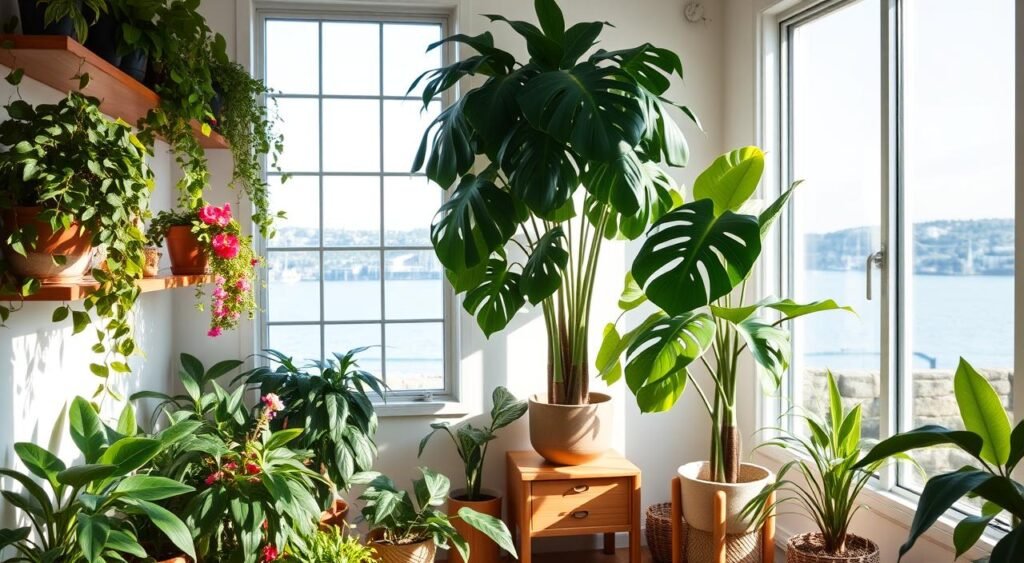
Before adding indoor plants to your home, start by evaluating natural light, space dimensions, and room purpose. This step ensures your houseplants thrive and fit your indoor gardening goals. Start by assessing how sunlight moves through each room.
Assessing Natural Light Levels
Track sunlight patterns daily. South-facing windows offer bright indirect light—ideal for most houseplants. North-facing areas work for low-light varieties like Snake Plants5. Use a light meter or observe sun shifts to map light zones. Edible plants like herbs need 6+ hours of sunlight daily.
Measuring Your Layout
Sketch floor plans to note furniture placement and open spaces. Group plants in odd-number clusters (3 or 5) for balanced aesthetics5. Leave space around pots to avoid overcrowding. Use vertical shelves for small spaces and tall plants in corners. Always use pots with drainage holes to prevent root rot5.
Considering Room Functionality
Offices benefit from air-purifying plants like ZZ Plants5 that boost productivity by 15%6. Bedrooms suit humidity-loving Peace Lilies, while kitchens can host herb gardens. Avoid placing plants near vents or heaters. Rooms with pets? Opt for non-toxi varieties like Pothos5.
“Rooms with indoor plants reduce stress by 37% and enhance mental well-being”5.
Choosing the Right Plants for Your Environment
Matching plants to your home’s conditions ensures they thrive. Start by assessing light, space, and household needs. Low light indoor plants and bright-light varieties have distinct needs, so selecting the best indoor plants requires careful evaluation7.
“Plants signal their needs through leaves and growth patterns. Listen to them!”
Low-Light vs. Bright-Light Plants
Snake Plant and Pothos excel in dim corners, needing little sunlight7. They’re top picks for low-light indoor plants. Bright-light plants like African Violets demand 6+ hours of indirect light to bloom. Use south-facing windows for these varieties7.
- Low-light champions: Snake Plant, Philodendron, ZZ Plant
- Bright-light favorites: African Violet, Fiddle Leaf Fig
Pet-Friendly Plant Options
Opt for non-toxic varieties like Pothos or Spider Plant. Avoid Peace Lily and Dieffenbachia, which are toxic if ingested8. Research plants thoroughly to protect pets and children.
Size Considerations for Indoor Plants
Choose containers that match a plant’s mature size. Dracaena can reach 8 feet tall, so place them where they won’t overcrowd rooms. Dwarf varieties like Mini Monstera fit small spaces7. Adjust placements as plants grow to avoid cramped setups.
Indoor gardening success hinges on aligning plants with your space. Prioritize light, space, and safety to create a thriving indoor oasis.
How to Use Light Effectively

Mastering light placement is key to thriving indoor plants. Whether using natural or artificial light, proper strategies boost growth and plant care success. Start by assessing window orientation and seasonal shifts to maximize photosynthesis.
South-Facing Windows vs. North-Facing
South-facing windows offer intense light (over 1000 FC)9, ideal for sun-lovers like succulents. North-facing areas provide 25-100 FC9, perfect for ferns or pothos. East or west windows fall between these extremes.
| Light Type | PPF (µmol/m²/s) | Footcandles |
|---|---|---|
| Low Light | 50-150 | 50-25010 |
| Medium | 150-250 | 250-100010 |
| High | 250-450 | Over 100010 |
Using Grow Lights
LEDs are top choices for indoor gardening due to energy efficiency11. Position lights 10-12 inches above plants11. Adjust based on type: seedlings need 4-6 inches, while flowering plants thrive at 6-12 inches10. Run lights 12-16 hours daily1110. Overexposure causes browning leaves9; check manufacturer guidelines.
- Place lights 4-6 inches above seedlings10
- Rotate plants weekly for even growth11
- Clean bulbs monthly to maintain efficiency11
Seasonal Changes and Light Availability
In winter, south-facing spots may lose 50% light intensity9. Move indoor plants closer to windows or add grow lights to meet daily light requirements. For example, flowering plants need 14-16 hours of light10. During summer, monitor for overheating near windows.
Plants in low light grow slower and use less water10
Adjust grow light schedules: reduce to 12 hours in winter and extend in spring10. Watch for leggy stems—a sign of insufficient light9.
Humidity and Temperature Considerations
Successful plant care starts with balancing humidity and temperature. Most indoor plants thrive in 40% to 60% relative humidity12. Dry winter air or forced heating can drop levels below 10%13, stressing houseplants. A simple fix: place a humidity tray with water and pebbles under pots to boost moisture naturally.
How Humidity Affects Plant Health
Low humidity causes leaf edges to brown and curl. Tropical species like ferns or orchids, which evolved in 70–90% humidity environments13, need extra care. Over-misting can promote mold, so use pebble trays or group plants to create humid microclimates instead.
Ideal Temperature Ranges
| Plant Type | Preferred Temperature (°F) |
|---|---|
| Cool-loving | 40–50 |
| Intermediate | 60–75 |
| Warm-loving | 75+ |
Digital thermostats12 help maintain stable temperatures. Sudden shifts—like placing plants near vents—force houseplants into survival mode, weakening their defenses against pests12. Keep plants away from drafty windows and heating units.
Tips for Creating a Humid Environment
- Cluster plants to increase local humidity through transpiration
- Use room humidifiers set to 50–60% for most species12
- Place moisture-loving plants like peace lilies in bathrooms where steam from showers naturally raises humidity
Cacti and succulents require lower humidity13, so position them away from humidifiers. Daily monitoring with a hygrometer ensures consistent conditions for diverse indoor plants.
Best Areas for Different Types of Plants
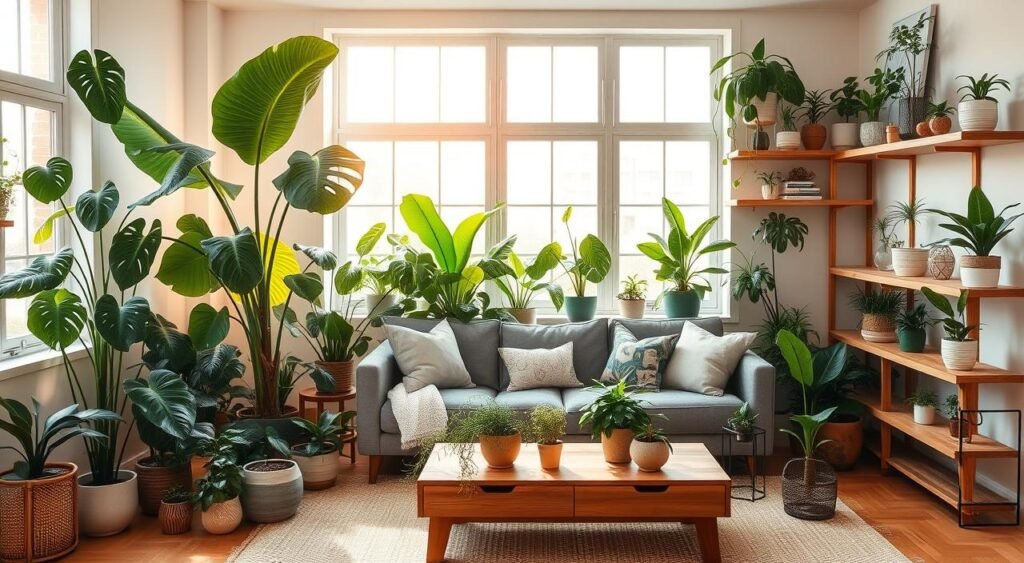
Optimizing indoor plant decor starts with matching plants to their ideal spaces. Whether you’re aiming for culinary convenience, restful sleep, or dramatic indoor gardening displays, plant selection and placement make all the difference.
厨房植物の新鮮さ
For the kitchen, prioritize herbs like basil or mint that thrive near windows with indirect light14. Plants like Pothos14 add humidity tolerance, perfect for steamy environments. Place small herb gardens on windowsills to enhance indoor gardening accessibility.
Bedroom Plants for Relaxation
Sleep-friendly rooms benefit from plants like snake plants or Calathea. These species release oxygen at night and filter toxins15. Opt for varieties under 3 feet tall to avoid blocking airflow. Philodendron15 adds soft greenery without overwhelming small spaces.
Living Room Statement Plants
Make a visual impact with Fiddle-leaf figs or Monstera, which can reach 10 feet tall14. Position large plants in corners to draw attention. Use trailing varieties like Tradescantia on shelves to add texture.
| Plant | Best Room | Light Requirement |
|---|---|---|
| Pothos | Kitchen | Low to high light14 |
| Snake Plant | Bedroom | Low light15 |
| Monstera | Living Room | Bright indirect light14 |
Combine best indoor plants with room function for harmony. Pair trailing varieties with shelves and bold foliage with open spaces. Adjust spacing as plants grow to maintain balance in your indoor gardening setup.
Creative Ways to Arrange Indoor Plants
Transform spaces with dynamic indoor plant decor by reimagining how houseplants occupy your home. Groupings and vertical setups turn ordinary indoor plants into statement pieces that enhance both style and function.
Indoor plants can lower stress and improve mental well-being, making them essential for modern living spaces16.
Grouping Plants for Impact
Cluster houseplants in odd-numbered groups (3, 5, or 7) to create visually balanced displays17. Pair plants with similar light needs but varying textures and heights. For example, a snake plant paired with a pothos and a fern forms a cohesive trio. Add a shared tray or basket to unify the grouping. Pro tip: Place clusters near windows or focal points to draw the eye17.
Vertical Gardening Techniques
Elevate displays with vertical setups using these options:
| Option | Best For | Tip |
|---|---|---|
| Ladder Displays | Small spaces | Use lightweight pots on ladder rungs for modern appeal17 |
| Wall Systems | High-traffic areas | Select moisture-loving plants like ferns for humid bathrooms17 |
| Hanging Baskets | Overhead spaces | Position at eye level for optimal balance17 |
Using Shelves and Stands
Maximize vertical space with furniture like the leafjoy® H20® collection, which offers compact arrangements for tight spaces16. Use bookshelves to layer plants at varying heights, or center a sculptural stand for a focal piece. Mix trailing plants like pothos with upright varieties for contrast. Rotate displays seasonally to adapt to light changes17.
- Pair a leafjoy® Cocoon® planter with succulents in low-light corners16
- Stack shelves horizontally to create a “living wall” effect
- Repurpose furniture like stools or carts as mobile plant stations
These strategies blend practicality and beauty, ensuring indoor plants become functional art in any room.
Avoiding Common Plant Placement Mistakes
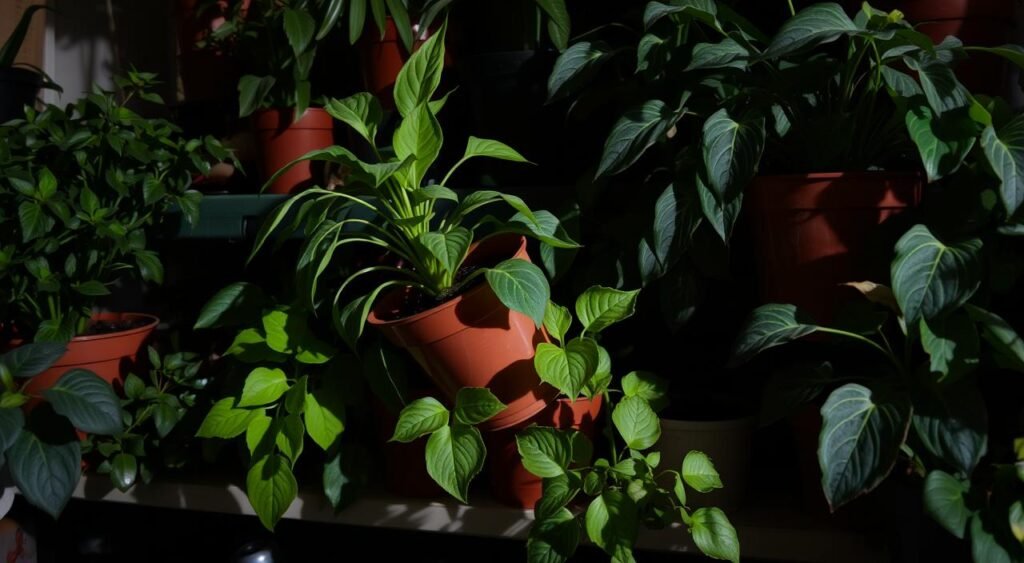
Even with proper plant care, indoor plants suffer when placed in harmful environments. Common errors like positioning houseplants near vents or overcrowding disrupt growth and health. Learn to spot and fix these issues to keep your plants thriving.
Near Heating/Cooling Vents
Forced air from vents dries leaves and stresses plants. Sudden temperature swings near vents reduce moisture retention18. Move plants 2-3 feet away to avoid direct airflow. Use shelves or curtains to buffer drafts while maintaining light access.
- Keep plants at least 2 feet from vents to reduce heat/cold exposure.
- Monitor soil moisture—dry spots form faster near vents18.
Overcrowding Plants
Crammed plants struggle with light competition and pest spread. Overcrowded houseplants develop yellow leaves and attract insects19. Leave 1-2 feet between mature plants for airflow. Rotate them monthly to ensure even light exposure.
| Mistake | Impact | Solution |
|---|---|---|
| Overcrowding | Pest spread, root rot | Space plants by mature size |
| Ignoring growth | Root binding | Repot when roots show drainage holes18 |
Ignoring Plant Growth
As houseplants grow, their needs change. Roots emerging from pots signal the need for larger containers18. Check stems and leaves for signs of stretching toward light—a clue to reposition or prune. Adjust spacing as plants mature to prevent overcrowding.
Seasonal adjustments matter too. Move tropical plants away from drafty windows in winter to avoid cold damage19.
Maintaining proper placement requires regular checks. Observe growth patterns and adapt setups to extend your indoor plants’ lifespan. Small adjustments now prevent major issues later.
Maintaining Your Indoor Plants
Regular plant care ensures houseplants thrive in their chosen spots. Adjust watering, feeding, and grooming based on each plant’s needs to keep them healthy and vibrant.
Regular Watering Tips
- Check soil moisture by sticking a finger into the top inch of soil—if dry, water thoroughly20.
- Snake plants and cacti need watering once or twice a month in winter, while peace lilies prefer drying between waterings21.
- Avoid overwatering, the top cause of houseplant death, by letting soil drain fully after watering20.
Fertilization Guidelines
- Feed actively growing plants during spring and summer using balanced fertilizers for flowering varieties20.
- Reduce fertilizer use in winter and follow label instructions to prevent root burn20.
- Snake plants and pothos need less frequent feeding, while orchids benefit from monthly spring/summer feeds21.
Pruning and Repotting
Trim overgrown stems in fall to encourage compact growth. Cut back leggy plants to 4-6 inches tall to spur new shoots20. Repot houseplants when roots crowd the pot’s base, using a container 1-2 inches wider to avoid stress21.
Indoor Plant Placement for Small Spaces
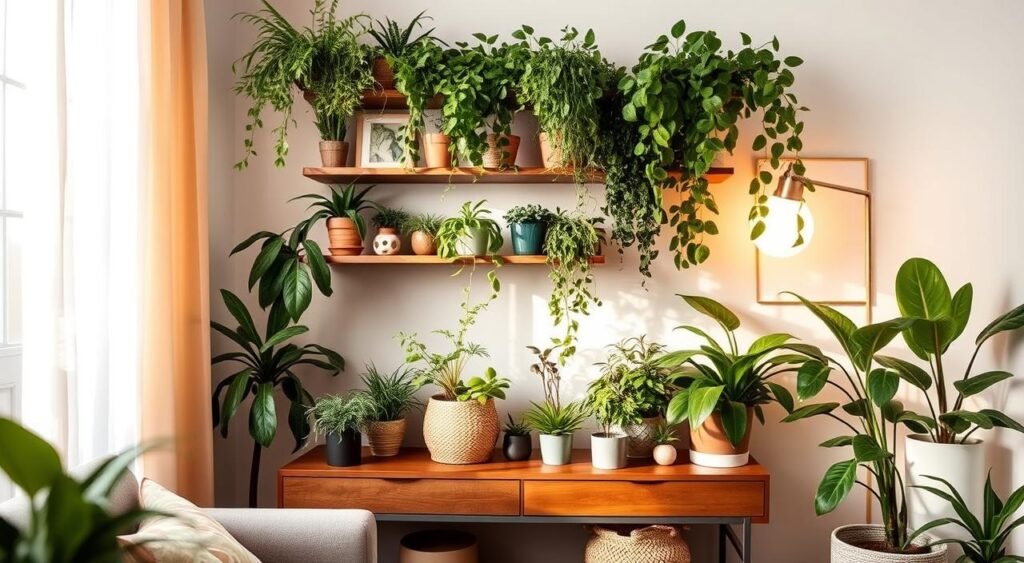
Maximizing indoor plants in small spaces requires creativity. Corner placements, hanging systems, and vertical setups turn tight quarters into thriving indoor gardens without clutter.
Utilizing Corners Wisely
Corners are often underused. Place large indoor plants like snake plants or fiddle-leaf figs to anchor spaces. Smaller corners work for terrariums or succulent clusters. These arrangements add greenery without dominating floor space22.
Hanging Plants Solutions
Hanging planters save space and add visual interest. Opt for trailing varieties like pothos or string of pearls. For kitchen areas, try herb gardens with parsley or thyme in suspended pots23. Choose durable planters with drip trays to avoid messes. Hanging options boost space by 30% and reduce floor use22.
Maximizing Vertical Space
Vertical indoor gardening techniques expand options. Use wall-mounted planters or tiered shelves. Options include:
- Plant hangers on walls for ferns or spider plants
- Mount floating shelves with small pots
- Install vertical planters for herbs like basil or mint
Wall planters systems save up to 50% floor space, while plant stands add 40% more vertical growing room22. A comparison of vertical solutions:
| Solution | Space Saved | Ideal Plants |
|---|---|---|
| Wall planters | 50% | Pothos, ZZ plant |
| Shelved displays | 40% | Succulents, air plants |
| Vertical gardens | 35% | Peperomia, ivy |
Combine these strategies to transform small spaces into lush indoor plant decor. Regular rotation and proper drainage ensure plants thrive in compact setups22. Experiment with these methods to create a vibrant, green environment without overcrowding.
Seasonal Plant Placement Adjustments
Adjusting where you place indoor plants with the seasons ensures they thrive through changing light and temperature conditions. Proper plant care includes shifting their location to match seasonal needs, like moving them away from drafty windows in winter or toward brighter spots in spring. Here’s how to create a year-round strategy for your best indoor plants.
| Season | Key Adjustments |
|---|---|
| Winter | Move plants 2-3 feet from windows. Use grow lights for 12-14 hours daily24. |
| Spring | Increase watering frequency and reintroduce fertilization at half strength every 4 weeks25. |
| Summer | Shield from direct sun using sheer curtains. Check soil moisture every 2-3 days25. |
As daylight shortens, shift indoor plants away from cold windowsills to avoid drafts. Use grow lights 12-14 hours daily to supplement light24. Reduce watering frequency—many plants enter dormancy and require 50% less water24. Maintain humidity with pebble trays or misters to counter dry indoor air from heating systems.
Gradually reintroduce plants to brighter light over 2 weeks to prevent sunburn. Prune no more than 20% of growth to encourage new growth25. Begin monthly fertilization at half the recommended dose to support active growth25. Inspect for pests weekly—overwintering eggs hatch in warmer spring temps24.
Shield plants from intense midday sun using sheer curtains or movable shades. Increase watering frequency by 50-100% compared due to higher evaporation rates25. Rotate plants monthly to ensure even light exposure. Water only when topsoil dries out completely to prevent root rot25.
Finding Inspiration and Resources
Continuing your journey in indoor gardening requires exploring resources that turn knowledge into thriving plants. Online communities like Instagram’s plant pages or forums like Reddit’s r/indoorplants connect enthusiasts sharing tips on placement and care. The Chicago Botanic Garden’s research shows indoor gardening boosts well-being for those with neurocognitive challenges26, making these spaces vital for both style and mental health.
Online Plant Communities
Join groups where experts discuss light levels and aesthetic trends. Platforms like Gardenia.net offer forums for troubleshooting common issues, while local groups like Chicago’s Green City Market workshops provide hands-on advice. Even a single snake plant can transform a room’s energy, as seen in countless success stories27.
Recommended Books on Indoor Plants
Titles like “The New Plant Parent” explain pairing low light indoor plants like pothos with dim corners26. Books often highlight the African violet’s adaptability to office desks, thriving in indirect light26. For beginners, the Bottle Garden Kit from The Sill offers a starter setup, while guides on humidity tips for spider plants can extend their lifespan26.
Local Nurseries and Workshops
Visit nurseries like Chicago’s Greenery Unlimited to ask staff about Dracaena’s corner placement or zebra cactus care. Workshops at the Chicago Botanic Garden’s Greenhouses feature 1,000+ plants, including winter-blooming Christmas cacti26. Local experts can advise on moisture management for office spaces, where dry air often challenges even hardy varieties like sansevieria26.
FAQ
Why is proper placement of indoor plants important?
What are some tips for assessing natural light levels in my home?
What types of indoor plants are best for low-light environments?
How do I know if my plant is getting too much or too little light?
Can you recommend some pet-friendly indoor plants?
What should I consider when selecting plants for different rooms in my home?
How can I improve the humidity levels for my indoor plants?
What are some creative ways to arrange indoor plants?
What common mistakes should I avoid with indoor plant placement?
How often should I water and fertilize my indoor plants?
What are the best strategies for incorporating plants into small living spaces?
How should I adjust my plant care routines with seasonal changes?
Where can I find more resources about indoor plant care?
Source Links
- It’s All About Positioning – The Best Places to Put Indoor Plants – https://www.geturbanleaf.com/blogs/tips-tricks/its-all-about-positioning-the-best-places-to-put-indoor-plants?srsltid=AfmBOop0lJs6x4QtqVdWj5CAl5rOvQRkRqs4nbvTXdAJaybzWlazeVn-
- How to Arrange Plants in a Living Room to Bring the Space to Life – https://www.thespruce.com/how-to-arrange-plants-in-a-living-room-6739917
- Health benefits of indoor plants – https://www.piedmont.org/living-real-change/health-benefits-of-indoor-plants
- 7 Science-Backed Benefits of Indoor Plants – https://www.healthline.com/health/healthy-home-guide/benefits-of-indoor-plants
- How to Arrange Plants In Your Living Room to Add Natural Style – https://www.bhg.com/gardening/houseplants/projects/decorating-with-houseplants/
- A Beginner’s Guide to Houseplants – advice – westland Garden Health – https://www.gardenhealth.com/advice/houseplant-care/a-beginners-guide-to-houseplants
- Selecting Indoor Plants | University of Maryland Extension – https://extension.umd.edu/resource/selecting-indoor-plants
- The Best Houseplants for Your Environment | HRC – https://houseplantresourcecenter.com/2020/04/the-best-houseplants-for-your-environment/
- Lighting for Indoor Plants | University of Maryland Extension – https://extension.umd.edu/resource/lighting-indoor-plants
- Lighting for indoor plants and starting seeds – https://extension.umn.edu/planting-and-growing-guides/lighting-indoor-plants
- How to Use Grow Lights for Houseplants – https://www.thesill.com/blogs/care-miscellaneous/how-to-use-grow-lights-for-houseplants?srsltid=AfmBOoqdpoMSvp_AQq7HiRqiv6FgJiLcxa20SyRcRGcbsek485v6-RKy
- Mastering Temperature and Humidity Control in Your Indoor Grow Space – https://www.ledgrowlightsdepot.com/blogs/blog/mastering-temperature-and-humidity-control-in-your-indoor-grow-space
- Temperature & Humidity – PlantTalk Colorado – https://planttalk.colostate.edu/topics/houseplants/1317-houseplants-temperature-humidity/
- 24 Best Indoor Plants – Find Your Perfect Houseplant – Garden Design – https://www.gardendesign.com/houseplants/best-indoor.html
- 15 Easy Indoor Plants for Beginners – Can’t Kill Houseplants – https://www.provenwinners.com/leafjoy/easy-indoor-plants
- 15 Ideas for Decorating with Plants – Add Life & Color to Any Room – https://www.provenwinners.com/leafjoy/decorating-with-plants
- Tips to properly arrange houseplants – https://www.promixgardening.com/en/tips/interior-design-with-indoor-plants
- 7 Common Indoor Plant Care Mistakes to Avoid – https://www.eplanters.com/blog/indoor-plant-care-101-7-fatal-mistakes/?srsltid=AfmBOop8ic00AlFVlTZtJNLwoUFlxc-q1P71qO2flkbIjoq2bfsDF54H
- Common indoor plant mistakes to avoid – 10 errors that are killing your houseplants, according to experts – https://www.homesandgardens.com/gardens/indoor-plant-mistakes
- 10 Tips to Ensure Happy, Healthy Houseplants – https://www.bhg.com/gardening/houseplants/care/houseplant-care-guide/
- Guide to Basic Care of Houseplants | Gardener’s Path – https://gardenerspath.com/how-to/indoor-gardening/houseplant-care-primer/
- 5 Indoor Plant Ideas For Small Spaces To Maximize Your Home – https://arterahome.com/blogs/all/5-indoor-plant-ideas-for-small-spaces-to-maximize-your-home?srsltid=AfmBOopj7Pl-oTSyKofu-Kow8OjwtyUs8nu5Yw8rgKhjnHut88VLVRwZ
- It’s All About Positioning – The Best Places to Put Indoor Plants – https://www.geturbanleaf.com/blogs/tips-tricks/its-all-about-positioning-the-best-places-to-put-indoor-plants?srsltid=AfmBOoozRMPxEHHMaOPEbFvSpDSgQwO_mF9_pUiZ8ss7ay2U0UkEi2rl
- How to Care for Your Houseplants in Winter – The Sill – https://www.thesill.com/blogs/plants-101/seasonal-care-winter?srsltid=AfmBOor4nD8UFlPcSvBNrCAUdCV_QBhJSlbjgwbCOjPgOPV8wj0UKFQm
- 6 Springtime Steps to Support Your Houseplants Through the Seasonal Shift – https://outsideinco.com/blogs/learn/6-springtime-steps-to-support-your-houseplants-through-the-seasonal-shift?srsltid=AfmBOoqtpnCoK-TQkrz2Z4C3KjpPmNa2ZPup0h4MqZcl8YV0tQU_FpD_
- Houseplant Rx: The power of indoor plants to soothe our souls – https://www.northshore.org/healthy-you/power-of-indoor-plants/
- allisa jacobs – How to Style House Plants Like a Designer – https://www.allisajacobs.com/how-to-style-house-plants/

